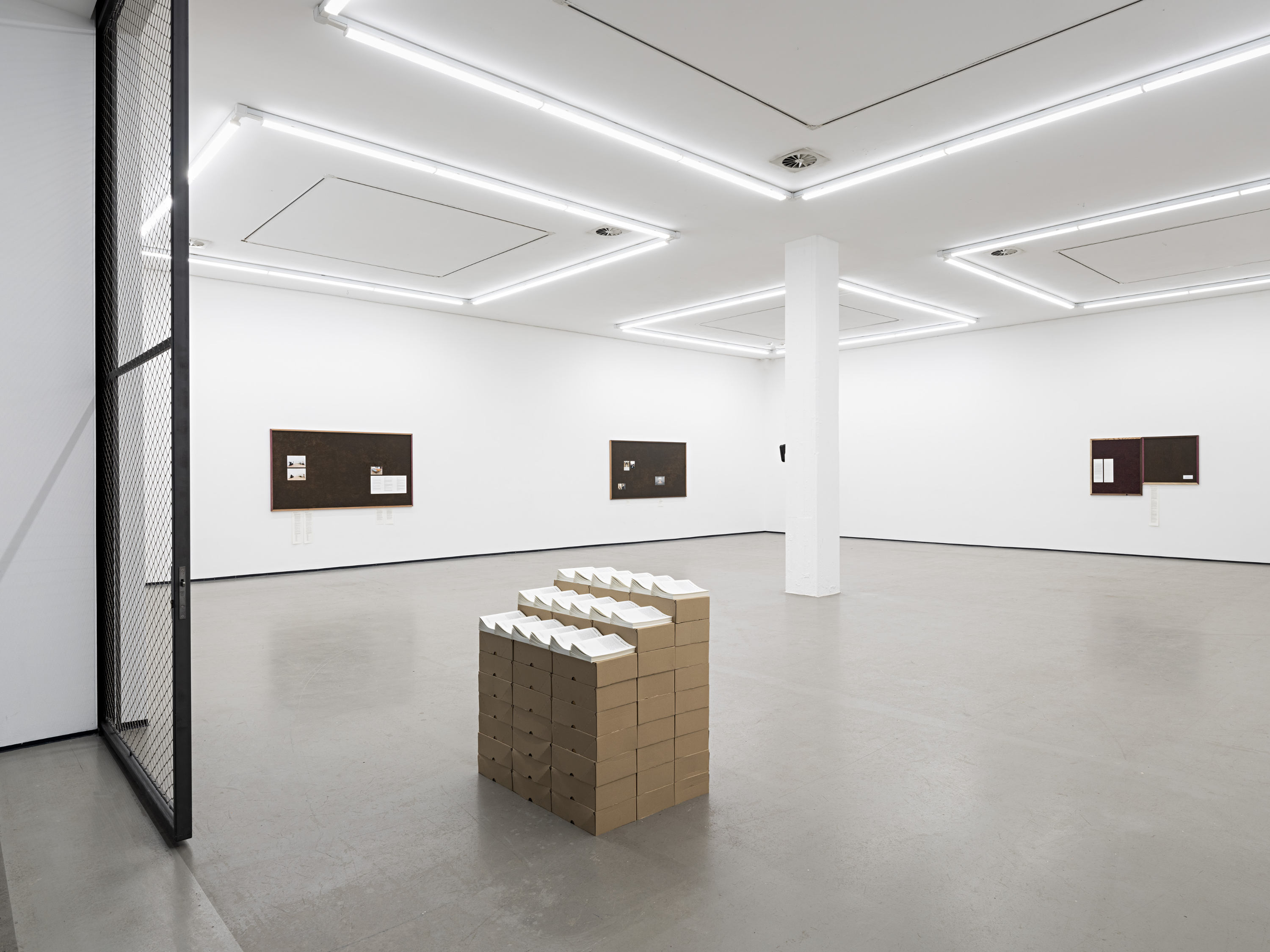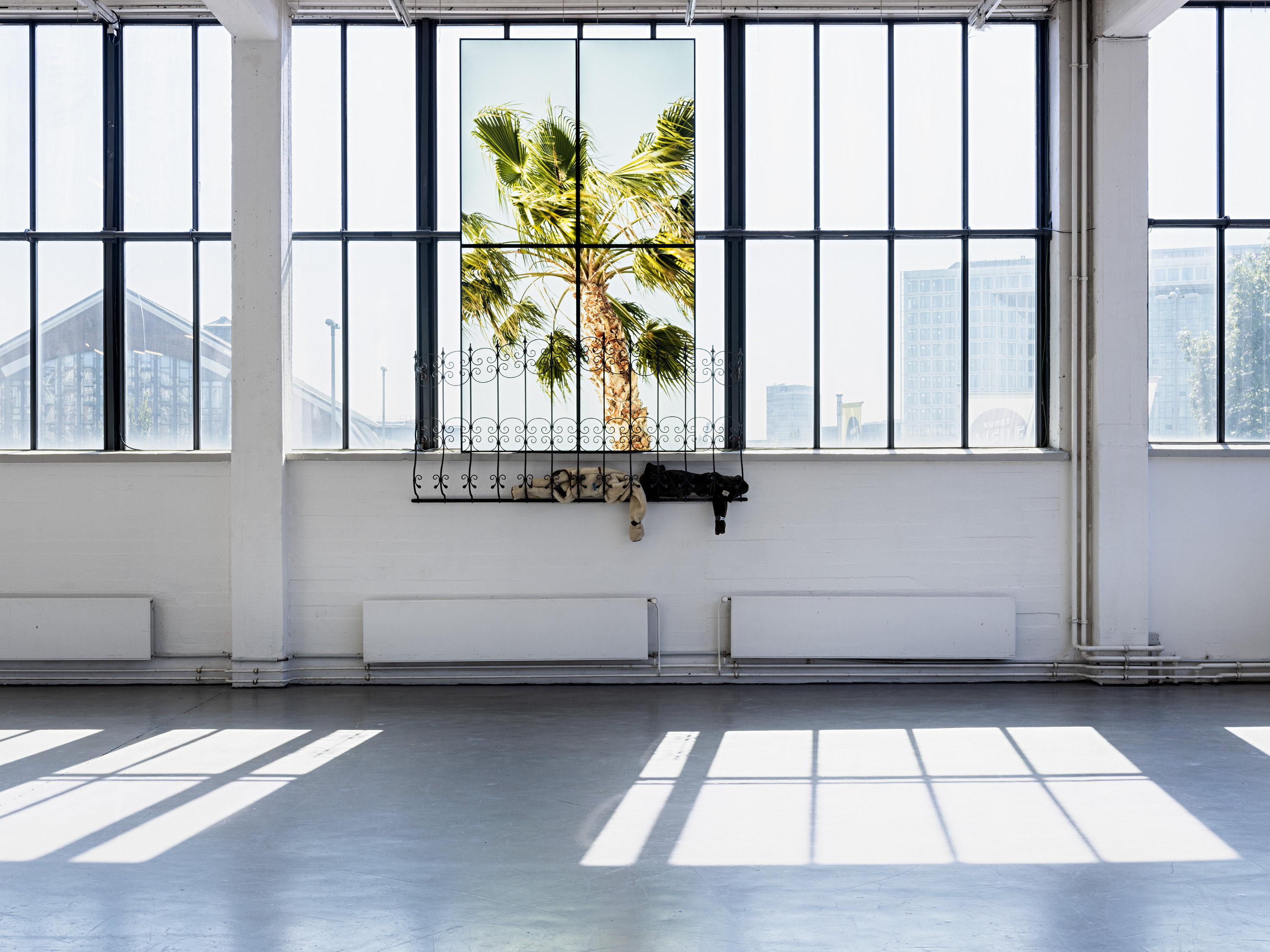Ima-Abasi Okon Avg Pace: S %∼ᴱ∼L%∼A%∼H%∼’s%∼peri£meno£pau£sal∼P%∼S%∼A %∼ᴸ∼M%∼’S km — (t!h!a!t-yes-t!!hat incumbent experiential plane to reorganise a c,a,p,a,c,i,t,y of never having enough — Not as a whole but as aprecise h!e!a!p of dignifide agility)
Kunstverein in Hamburg
9 September 2023 – 7 January 202416-11-2023
Aspiration — a hope, a desire, a breath. The word derives from the Latin “to breathe on, or blow upon.” When combined, these definitions evoke the image of a body filling up with oxygen and with potential. After being in Ima-Abasi Okon’s solo exhibition “Avg Pace: S %∼E∼L%∼A%∼H%∼’s%∼peri£meno£pau£sal∼ P%∼S%∼A %∼L∼M%∼’S km — (t!h!a!t-yes-t!!hat incumbent experiential plane to reorganise a c,a,p,a,c,i,t,y of never having enough — Not as a whole but as aprecise h!e!a!p of dignifide agility)” at Kunstverein in Hamburg this fall, I kept thinking about breathing as both a life supporting function and a potential form of transformational labor perhaps best embodied by the runner. While we all need to breathe to live, to move, to flourish, it’s part of the runner’s work to do so: their aspiration, so to speak, is to maintain aspiration. Aspiration has a time limit, though, and must be constantly calibrated and recalibrated; tested against other runners who exist in a collective time-keeping body. Even as others may try to profit off the runner’s labor and the image of their labor, the runner’s expressions — from the subtle to the theatrical — are impossible to obfuscate (think of Tigst Assefa gliding first across the finish line in her spaceship shoes at the 2023 Berlin marathon, or Emil Zátopek, “wrestling like an octopus on a conveyor belt” towards one of his many Olympic victories¹). Of course, some people run (much) harder and faster than others, yet for all runners (elite and hobbyist) there’s an inextricable connection between the body’s aerobic limit and how fast and far that body goes. To me (a person who has only ever made it to 4,5km, but had a blistering time in her elementary school mile run), the runner seems like the ideal model for an emancipated worker: their bodily labor cannot be separated or abstracted from the very metabolic processes that make that labor possible in the first place.
Ima-Abasi Okon is an artist and a runner. In the Kunstverein show — which includes a parallel exploration of the production of value around artistic labor in the form of a self-organized miniature exhibition “S.t.a.n.d.a.r.d. P.r.a.c.t.i.c.e” — the signs of a runner’s world and the runner’s work are present in both straightforward paraphernalia and in more ephemeral and visceral interventions in the space. In her video, sculptural and sound works, which also combine a collection of ready-made objects, Okon produces unexpected acts of aspiration — breathing and becoming — in order to imagine spaces of liberatory and collective practice.

“S.t.a.n.d.a.r.d. P.r.a.c.t.i.c.e” on the Kunstverein’s ground floor, proposes visible and collective control of artistic labor (and the expression of that labor) by artists themselves, who here share photographic documentation of their work with an accompanying license detailing the parameters of use. Images of work by Appau Jnr Boakye-Yiadom, Anthea Hamilton, Dominique White and Riet Wijnen (the Van Abbemuseum also lent documentation of two publications by stanley brouwn) are mounted on lacquered chipboard. A rostrum-like stack of booklets containing an anonymous essay written on behalf of the artist states that institutional and art historical “standard practice” renders artistic work (including the labor inherent in that work) as (private) property. In turn, a museum or gallery's licensing of documentation boosts their institutional reputation by commodifying artistic uniqueness and genius (an additional factor often seen as an autonomous yet uncompensated surplus value). The presentation of these photographic documents and licenses are fixed to Okon’s work — the chipboard supports known as Mahalias are part of an ongoing series named for the American gospel singer Mahalia Jackson — embedding this challenge to institutional extraction within the artist's own practice and producing a shared work that bucks consolidated ownership. Doubling down and also complicating expressions of ownership is a looped refrain from Whitney Houston’s 1992 chart-topping pop song I’m Every Woman, which intermittently erupts from a speaker at the center of the gallery. As “It’s all in me...” plays again and again, this statement of corporeal and spiritual substance — tautological by nature (I am what I am) — also takes the form of a prophetic warning in which Houston’s voice runs breathlessly towards a cut and repeat. Yet all the while, the three Mahalias with their thick, shining varnish evoke Jackson's slowed-down and supple singing. These hybrid, layered canvases propose a different kind of circulation — a circulatory system—that arrests the normal operating functions of the art institution.
Upstairs, Okon’s solo exhibition — on display in a vaulted, window-wreathed gallery — combines the fast and slow, electronic and organic. Visitors first encounter three video works each consisting of four 4K monitors, secured to south and west-facing windows. Across the fused screens, spindly palm trees, rendered in sublime high-definition at various angles and distances, rustle in a breeze. Three ornate, wrought-iron Juliet balconies finish this work, bolted below the window ledge and fitted around the base of the monitors to both contain and frame its image.² Stashed in the balcony's curve is a pair of shearling jackets, each with a Garmin Forerunner strapped to the arm, which is fed biometric data gleaned from members of the London-based artist worker’s cooperative not/nowhere.³ Here, the runner comes most explicitly into frame, though in spectral form: the body is absent, leaving behind a soft shell and a biometric identity that ticks by in real time. Yet even as the palms (shot on location in Los Angeles) and their balconies symbolize the extraction of labor through processes of cultivation and the accumulation of wealth, there’s a transformative vitality to these sculptural compositions. The symbols of oppressive aspiration — unequally distributed, dehumanizing — are interrupted by the casual and literally-charged signs of active life.
At the center of the space, a pair of hand-built and automated Leslie speakers⁴ face a cane chair holding stacked packages of dehydrated and vacuum-sealed oxtail soup mixed with ashwagandha and lion’s mane.⁵ At intervals, a genre-defying soundtrack emerges from the speakers — like a stretched out Wurlitzer with muted, percussive beats and silky electrified guitar riffs.⁶ The backside of each speaker is left open, revealing its amplification mechanisms, which spin and pump, uniting the sonic and the architectonic. Hidden within the speakers’ cabinet, a kombucha mother continues to ferment during the run of the exhibition, aided along by the speakers’ movements and in turn lending a mechanical engine to the aerobic one already inside the work.⁷ Like fermentation or the runner’s respiration, the speakers’ very substance, its internal mechanisms, are interconnected, possibly indistinguishable from its external expressions; from its sound. Synced to the languid movement of the palm trees, the soundtrack becomes a stunning musical benediction, drawing the historical and infrastructural toward the metabolic and personal.
I’ve never seen the Kunstverein space quite like this: colossal yet intimate; ghostly yet filled with presence. While a curatorial text situates the work in the vein of institutional critique — calling into the gallery (a former market hall) regimes of extraction and productivity that reflect Hamburg’s colonial history and architecture — there’s a different kind of temporal engagement at play here. Okon has often spoken about the slow pace or gait of her work and especially its titling, which demands a form of immersive sight-reading. The sound swirling through the gallery seems to announce an aerobic threshold that calibrates and recalibrates discrete works into a single, unified gesture. In other words, there’s an audible, musical breath in the space, a motor that aspires toward an equilibrium on the inside (out of view; the labor perhaps), that is intricately bound up in—indeed inseparable from—what we see, hear, feel. Here again, we might see the artist like a runner, who sets out not necessarily in pursuit of reward but for the balanced pleasure of the stride.

- Jon Day, “Hang up your running shoes,” London Review of Books, 38, No. 19, October 2016.
- Each of these works has a different title and consists of the same elements: BrightSign 4K monitors, morphine, wrought iron balconies. i) The figure of the legislator and the notion of the welfare state sksksk skrs skrt, 2023; ii) The figure of the spirit and the notion of the company sksksk skrt skrrt, 2023; iii) The figure of the salaried employee and the notion of employment sksksk skrt skrrrt, 2023.
- Ima Abasi Okon, A precise peaking and tapering dignity tool; A hip-flexor R.O.M. fullnessered corp through succession, 2023.
- Ima Abasi Okon, (A) The subordination (G) of the unique (I) to the interests of the identical (L) within the sphereof force without trespassing (I) the principle of freedom (T) is as necessary as proto realm FIDE-flexing, 2023.
- Ima Abasi Okon, Anticipated — yet unexpected —Anticipation of W-hoop W-h-oop W-h-oooooooo-oooping of thrown Intense Concealment [!voluminous!- -as- -!possible!] as Surprise and Auntie’s Serenading Astonishment: The weight generates no significant !witness! until it is put in formalrelation with varied multidirectional (spirit) groans, 2022.
- Ima Abasi Okon, alongside-ness with-out identification1 + excess over the original value1< (C-------r--------y-------F--------o--------r--------Y--------o--------u), 2023.
- Ima Abasi Okon, 120 minutes congregants’ politic of sermonary configurations, 10 x 90 sec of/on murmurings, 15 mile progression of agency of life of free-from of lavender of metabolic capacity of, of, of, of, of of of of the feeling that it is suddenly and inexplicably very easy at least for a while, of of, of, of, of, payout community sustenance of ,,,,,,,,,,,,,,,,,,,,,,,,,, of heart rate, of elevation gain of no onThe Mountain Top! Of E-eee-lapsed time of of, of, of, of, elevation loss of distance of Hibiscus&Ginger of love of of of of inactive glutes of zoning/redlining of elecampane, on, on, on, on, on,,,,,,,,, cadence on on on/off off off Est. <a G—I—F—T>, 2022.